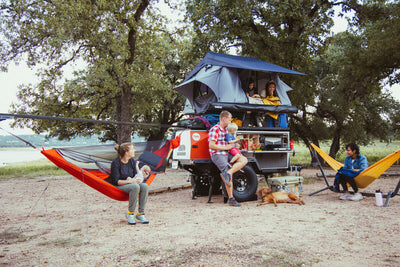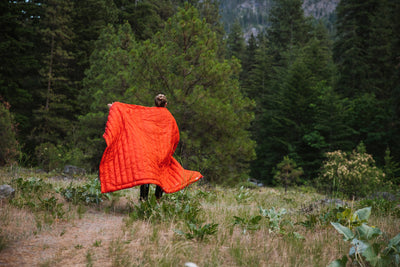Your guide to hammock safety
Five things you must know for hammock camping safety.
This month, we’re celebrating hammock camping and all the adventures you have hanging. Beyond a better night’s sleep, camping in the air leaves a lighter footprint than pitching a tent on the ground, has positive benefits for bad backs, and keeps you above the crawly night critters. Better for you and the planet all around, when done with safety in mind.
With all of our knowledge on hammock design and the activity of hammock camping, plus a little help from National Parks Ranger Dan Sholly, we're writing the book on hammock safety to keep you off the ground and in the air all night long.
If you’re new to hammock camping or even a seasoned pro, read on for safety tips from Ranger Dan and the team at Kammok.
1. Check your surroundings.
Structure check.
First thing's first. Always check park rules about hammock camping. Some state and national parks may prohibit hammock camping. If hammock camping is prohibited, inquire about the potential to hammock between camp structures (roof coverings, gazebos, etc.) or between two cars. Make sure you only hang your hammock off of a pole or structure that is weight bearing to your body weight.
Steer clear of trails.
When setting up camp, stay away from hiking paths and game trails. According to Ranger Sholly, you should avoid any area that are thoroughfares for humans or animals. “Don’t put up any rope or line that would possibly be a tripping/blocking hazard to someone in your group or a neighboring campsite.” Hats of to you, Ranger Sholly. We concur.
2. Choose your support.
Between two trees.
Would you put your life in the hands of something no longer alive? Check yes or no. The correct answer is no.
Finding a safe spot to hang is important. When choosing your hammock support, ideally choose sturdy and living trees that are 10’ to 12’ feet apart. We want to emphasize that the trees you hang from should be living, not dead.
Be on the lookout for what Ranger Sholly calls hazard trees. “A tree doesn’t have to be dead in order to pose a safety threat. Some hazard trees are obvious: big lean, rotten or cracked wood, et cetera...”
Tree-less? Not a problem.
“In front country or more developed campgrounds, there may be shade/wind shelters that may provide support for hammocks. Your vehicle may [also] be a good anchor.” Ranger Sholly recommends bringing a portable support anchor mechanism, if you think you might need it.
When getting creative about where to hang your hammock, ensure your weight is fully supported. Boulders and even trekking poles can do the trick, just check your stability! Hammocking shouldn't leave you between a rock and a hard place.

3. Always sit, then swing.
Sexy photos are tempting, but your life isn't worth the likes. Hang low. Aim to hang about 18” off the ground (knee high) when sitting in your hammock. Your hammock should have a gentle curve when suspended - not too loose or too tight. You can adjust straps to be slightly tighter if you need to lay flat in your hammock.
When entering your hammock, sit first then swing your legs in. We recommend laying diagonally for sound sleep and to prevent your hammock from cocooning. A 30-45 degree angle should do the trick. Need more convincing to sleep above the rocks? We've got you.
We don’t recommend standing, jumping, spinning, or cartwheels in our hammocks. Save those for solid ground and save face.

4. Take shelter.
Before you head out, always check the weather for temperature, precipitation, wind speed, and potential storms. Preparing for the elements is critical to hammock camping safety.
“Healthy trees can come down in a storm, killing, and injuring people. The whole tree doesn’t have to come down in order to hurt someone. Large branches can break off.” Ranger Sholly recommends checking the forecast ahead of time not only for storms, but wind speeds, as well.
We know that some of you don't let the weather get you down. To you we say, touché. When you're committed to staying outside, bring a weather shelter for your hammock. Shelters can protect you not only from rain and wind, but the sun’s UV rays, as well. We recommend our Kuhli weather shelter. With 16 attachment points for unlimited setup modes, the Kuhli keeps you sheltered in any weather.
Bug nets are another must have for hammock camping. The Dragonfly insect net gives you 360 degree protection from mosquitoes and other no-see-ums.

5. Protect our parks.
Leave no trace. “In short, be respectful of the resource. Do no harm. Don’t disturb wildlife… it’s their home. Leave a campsite in better condition than you found it.”
Don’t forget to bring along your Python Straps. Python Straps are made of tree-friendly webbing that minimize negative impact on tree bark.
About Ranger Dan Sholly

Ranger Dan Sholly served as a park ranger in Hawaii Volcanoes National Park, Crater Lake National Park, and Yosemite National Park during his decades-long career. He also served as chief ranger of Yellowstone National Park and chief ranger of the National Park Service in Washington, DC.
We want to keep you hanging safe in your hammocks. Read our entire interview with Ranger Dan Sholly here. Feel free to comment below with any other safety questions or tips you want to share with the Kammok community.




